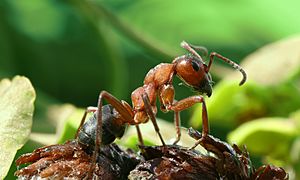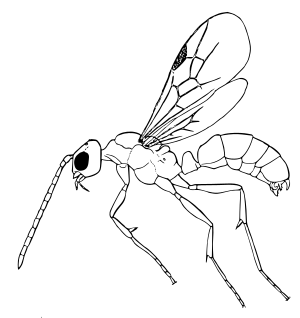List of ants of Great Britain facts for kids
This article is about the different types of ants you can find in Great Britain. Great Britain has fewer kinds of ants compared to other parts of Europe. This is mainly because of the summer soil temperature. Ants like warmer places, so most of the different ant species live in the warmer parts of the country.
The counties with the most ant species are Dorset, Hampshire, Surrey, the Isle of Wight, and Kent. For example, Dorset has 33 different types of ants!
Some ants, like the common black garden ant (Lasius niger) and the red ant (Myrmica rubra), can live almost anywhere. They are found in many different places, even where people live. These ants are very common across most of Great Britain.
However, most ant species in Great Britain need very specific places to live. Many rare species are found on undisturbed heathland in the south, where the summer soil is warmer. Six species even depend entirely on other ant species to survive after they start their colonies.
Many of the less common ants are at the northern edge of their natural range in Britain. This means they are only found in the warmer south. Some ants that usually live on heathland can also be found in parks, partly wooded areas, and large gardens. Examples include Formica fusca/lemani, Lasius mixtus/umbratus, and L. fuliginosus.
Other ants live in forests. These include the well-known wood ants, like the southern wood ant (Formica rufa), and the more northern F. lugubris and F. aquilonia. These large ants build big nests from leaf litter. You can still see these nests in many old forests and woodlands across the country.
A few smaller, harder-to-spot ants also live in wooded areas. Stenamma species, Leptothorax acervorum, and Temnothorax nylanderi can be found under stones, logs, or loose bark in established woods. The ant Ponera coarctata also lives under stones. It is one of two native British ants from the Ponerinae group. The other is P. testacea, which likes very warm, dry places.
This list mainly follows a book called Naturalists' Handbooks 24 : Ants from 1996. Some new ants have been added, and some corrections have been made since then. Ants that have been brought into Great Britain from other places are marked with an asterisk (*).
Contents
Ants with One Waist Segment (Dolichoderinae)
These ants have a waist with only one segment, called the petiole. Their main body part (gaster) has four segments you can see from above in females (workers and queens). They do not have a sting.
- Linepithema humile, Argentine ant *
- Tapinoma erraticum, erratic ant – A small black ant found in southern Britain. It builds nests on heathland and is known for making sunny spots (solaria) for its nests.
- Tapinoma subboreale – Another small black ant found in southern Britain, nesting on heathland. It was previously known by other names.
- Tapinoma melanocephalum *
Ants with Five Gaster Segments (Formicinae)
These ants also have a waist with one segment (the petiole). Their main body part (gaster) has five segments you can see from above in females. They do not have a sting.
- Camponotus sp., carpenter ants *
- Formica aquilonia, northern wood ant – This wood ant builds tall, cone-shaped nests made of twigs and leaves. It is found in the highlands of Scotland and a few places in Ireland, but not in England.
- Formica cunicularia – A large ant often with some reddish parts. It is quite common in parts of southern England and nests in small earth mounds.
- Formica exsecta – A large ant with a special head shape. It is found in Devon and the highlands of Scotland. It builds small nests made of twigs and leaves.
- Formica fusca – A large black ant that is common in southern Britain.
- Formica lemani – Very similar to F. fusca, but it has more hairs and lives in more northern and western areas.
- Formica lugubris, hairy wood ant – Very similar to F. rufa but lives further north. It can handle more shade than F. rufa or F. aquilonia, so it is often found in thicker forests.
- Formica picea, black bog ant – A rare, shiny black ant. It nests in grassy clumps in marshy ground in the New Forest, Dorset, and South Wales.
- Formica pratensis – A wood ant that is probably now gone from England. It was last seen in Dorset in the late 1980s. You can still find it on the Channel Islands (Jersey and Guernsey).
- Formica rufa, red or southern wood ant – A large ant that builds big nests from twigs and leaves in open woodlands.
- Formica rufibarbis – A large, rare ant found in a few places in southern England and the Scilly Isles. It looks similar to F. cunicularia.
- Formica sanguinea, blood-red slave-maker ant – This ant is redder than other Formica species. It can make other ant species, usually Formica fusca, its slaves.
- Lasius alienus – A small black ant found in chalky grasslands.
- Lasius brunneus, brown tree ant – A small, two-colored ant that nests in trees, especially old oak trees. It is found in woods and parks.
- Lasius emarginatus – A small, two-colored ant from Europe. It was found in the Channel Islands but not the mainland until a colony was discovered in London in 2008.
- Lasius flavus, yellow meadow ant – A very common yellow ant. It builds large earth mounds that can last for many years in undisturbed grasslands. It also nests under stones and in garden lawns. It mostly lives underground, so you don't often see it on the surface.
- Lasius fuliginosus, jet black ant – A large, shiny black ant with a heart-shaped head. It nests in tree stumps and hedgerows and is found in scattered locations. New colonies are started by queens adopted by L. mixtus and L. umbratus ants.
- Lasius meridionalis – A yellow ant that lives underground in sandy lowlands. New colonies are started by queens adopted by Lasius alienus ants.
- Lasius mixtus – A yellow ant that lives deep underground among shrub roots and under large rocks. Sometimes it builds mounds of fine soil. New colonies are started by queens adopted by Lasius alienus, L. niger, or L. brunneus nests.
- Lasius neglectus * invasive garden ant – A small brown ant that forms huge colonies in parks and gardens. It was first found in Gloucestershire in 2009 and is likely to spread.
- Lasius niger, black garden ant – Common in towns, nesting under paving stones and in gardens. It also builds mounds of loose soil in fields.
- Lasius platythorax – Looks very similar to Lasius niger but nests in cooler, damper places. It typically nests in dead wood and does not dig in the earth.
- Lasius psammophilus – Very similar to Lasius alienus. It is found in sandy areas.
- Lasius sabularum – A yellow ant that lives underground.
- Lasius umbratus – A yellow ant that lives underground, nesting under rocks, in tree stumps, and at the base of old trees. New colonies are started by queens adopted by Lasius alienus, L. niger, or L. brunneus nests.
- Paratrechina vividula *
- Paratrechina longicornis *
Ants with Two Waist Segments (Myrmicinae)
These ants have two segments in their waist: the petiole and the post-petiole. Female ants (workers and queens) usually have stings.
- Anergates atratulus – This is the old name for Tetramorium atratulum.
- Crematogaster scutellaris * – A southern European ant that nests in trees. It might be brought into Britain with cork and has recently been found in some buildings.
- Formicoxenus nitidulus – A "guest ant." It lives inside the nests of the much larger Formica rufa ants.
- Leptothorax acervorum – A small ant that nests in tree stumps, under stones, and in peat.
- Monomorium pharaonis, pharaoh ant *
- Monomorium salomonis *
- Myrmecina graminicola, woodlouse ant – It is called this because it rolls into a ball when disturbed, like a woodlouse. It is a dark and slow-moving ant, found in specific local areas.
- Myrmica hirsuta – A rare ant that is almost workerless. It lives as a parasite in the nests of Myrmica sabuleti.
- Myrmica karavajevi – A workerless parasite that lives in the nests of Myrmica sabuleti and M. scabrinodis.
- Myrmica lonea – A rare red ant found in Scotland, nesting in soil and under stones.
- Myrmica lobicornis – Not common. It is found on lowland heath and in open woodlands.
- Myrmica rubra, red ant – A common ant in low-lying areas, especially near rivers where the soil is rich.
- Myrmica ruginodis, red ant – A common ant found in woodlands, where it nests in tree stumps.
- Myrmica sabuleti – A red ant, common in some areas, nesting in sunny, sheltered spots.
- Myrmica scabrinodis, elbowed red ant – A common red ant that lives in many different places. It is often found with the yellow meadow ant Lasius flavus, but also in woodlands, coastal areas, riverbanks, and moorland.
- Myrmica schencki – This red ant is active at night and is not common.
- Myrmica specioides – A rather local red ant. It nests in coastal sand, gravel banks, and old industrial sites. Sometimes called Myrmica bessarabica.
- Myrmica sulcinodis – A dark red ant found in well-drained heather moorland.
- Myrmica vandeli – A rare red ant found in warm, boggy areas.
- Pheidole megacephala *
- Solenopsis fugax thief ant – It has very small yellow workers and nests deep underground. It often lives near Lasius flavus or Formica species, stealing food from them.
- Stenamma debile – A small ant that is easy to miss. It nests in woods under stones and in leaf litter. It is more common than Stenamma westwoodii, which it was often confused with until recently.
- Stenamma westwoodii – A small ant that is easy to miss. It is less common than Stenamma debile, which it was often confused with until recently.
- Strongylognathus testaceus – This ant must live with Tetramorium ants.
- Temnothorax albipennis – A small ant found in warm coastal areas, nesting in cracks in rocks.
- Temnothorax interruptus – A small, uncommon ant.
- Temnothorax nylanderi – A small ant found in leaf litter in woods.
- Tetramorium atratulum – Previously known as Anergates atratulus. This ant is a parasite that has no workers and lives in the nests of Tetramorium caespitum.
- Tetramorium caespitum – Tends to live near the coast and forms large colonies.
Ants with a Thickened Petiole (Ponerinae)
The petiole (waist segment) of these ants is thick and knot-like. There is often a squeeze between the first and second main body segments. Workers and queens have working stings.
- Hypoponera punctatissima * – An ant found all over the world. It is sometimes seen outside buildings.
- Hypoponera ergatandria * – Previously named Hypoponera schauinslandi. Another ant found all over the world, rarely seen outside buildings.
- Ponera coarctata – A simple type of ant that forms small colonies under stones. It is found in warm places.
- Ponera testacea – This ant was once thought to be a type of P. coarctata. It is mainly found in the Mediterranean region and is rare further north in Europe. It lives under stones in open, very warm, dry places. It was first identified in coastal South East England in 2010 and is now found in several coastal spots from Cornwall to Suffolk.
See also
- List of ant genera (alphabetical)
- List of Hymenoptera of Ireland




